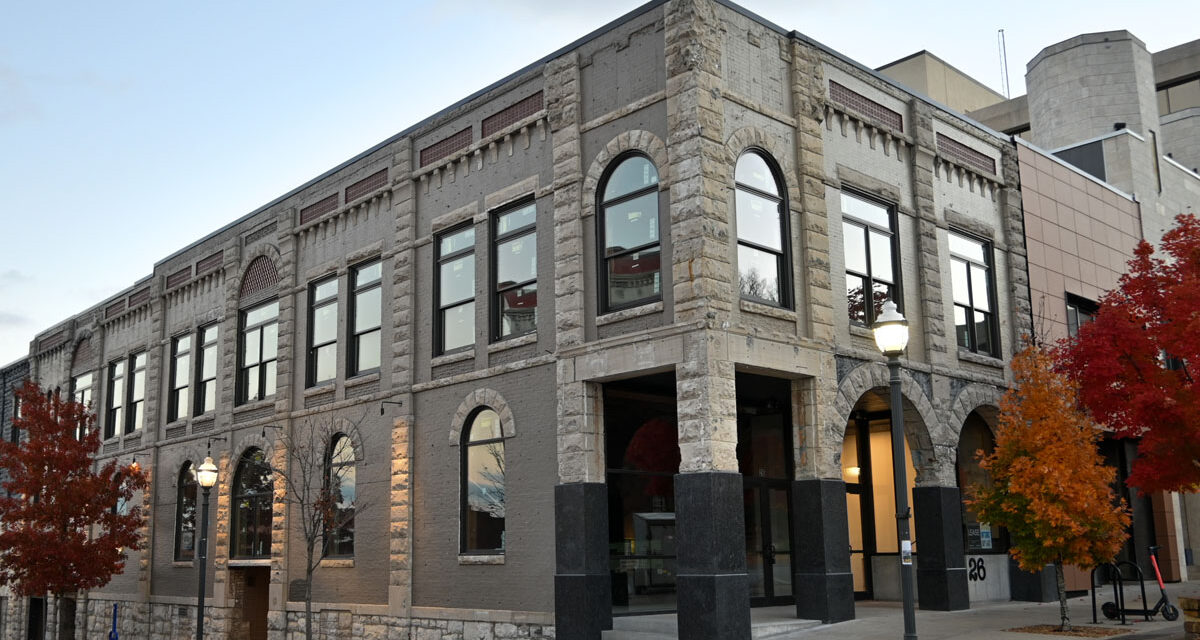In 1964, the building at 26 W. Center on the Fayetteville Square was “renovated” with a Mid-Century Modern screen that covered the original structure. Only by looking carefully could one perceive the vague outlines of arches behind the screen. In the summer of 2018, the building’s new owners and their architects began a journey to reveal the masonry masterpiece that had been hidden for over 65 years. Generations had come and gone without knowing there was an exquisite Richardsonian Romanesque jewel right in the middle of town.
From its beginning in 1898, this grand edifice served as a robust venue for a variety of businesses and professional offices. Archival photos and recollections of longtime residents spoke of the vital role that 26 W. Center played in the cultural and civic life of Fayetteville. Almost 25,000 square feet were filled with three stories of bustling enterprises that included a drug store, general dry goods store, realty company, and dental and architectural offices, among others. From 1924 to 1981, the ground level anchor tenant was First National Bank.
When the restoration began, the building was vacant and not suitable for habitation given its lack of fresh air, daylight and circulation, as well as its fortress-like character. The design intent for the project was to unveil and restore the original facade to be as authentic as was feasible and to establish new interior circulation. An overarching theme was to create a pedestrian-friendly presence to match the robust vibe on Center Street and Block Avenue.
Research has shown that the likely architect and stonemason was D.C. Wurtz, who also built the nearby 1905 Washington County Jail. All the stones were hand-cut from local quarries before construction began. Wurtz’s entry design of 26 W. Center is notable because, by virtue of an open arcade (loggia), the entry can be entered from both Block Avenue and Center Street. Also, the bank had one of the earliest drive-thru deposit services in Arkansas. A former bank employee, Mildred, participated in an early walk-through and explained how she used a system of mirrors and a conveying system that delivered deposits from customers in their cars to her “snorkel room” under the sidewalk on Block Avenue. That equipment was left intact as it was found.
This was a complex project that overlapped several preservation categories — preservation, restoration, reconstruction and rehabilitation were all applicable to one degree or the other. The initial 1960s facade deconstruction included removing a metal rain-screen, heavy granite wall panels and concrete block in the original window openings and stripping tar and paint from the stone with a nontoxic gel. Then, energy-efficient-clad wood windows were placed in the original openings, many with dramatic arch tops. The building was brought up to code through the design of new stairways and entries to Block Avenue and Center Street, as well as new interior corridors, bathrooms and utility networks.
A substantial challenge included inserting interior stairways and corridors around historic structural systems and three large concrete bank vaults. Frequent structural assessments occurred as layers were removed to determine restoration solutions, such as the design of the three-level staircase on Block Avenue, most likely in its original location. A beautiful vault door was left exposed within so that it could be appreciated as one travels up and down the new daylight-filled stairwell.
Innovations involved deduction of where original circulation occurred by observing structural conditions (and old grainy photos) and reestablishing those patterns to meet egress codes, all while maintaining the original integrity of the building. This included not only the new stairwell but also two new major access points on Block and Center that are connected internally to create a multilevel egress backbone. To make the basement space viable, a new entry from Block Avenue was threaded between levels by working with the existing column pattern. A final keystone of the restoration was returning the original loggia (arcade) to the square, which had been enclosed during one of the many building updates.
At the start of restoration, the building was not only obscured, but also severely dilapidated and out of code compliance. The new owners, architects and build team all held to a commitment for a quality restoration and rehabilitation that honored the architecture of the original Wurtz Building and consulted local historical resources. The end result serves as a window into Fayetteville’s historic legacy and sets the stage for this landmark to contribute once again to the vibrant life of the Square and Fayetteville.
On Jan. 28, 2022, Preserve Arkansas representatives Rachel Patton and Hunter Windle presented 26 W. Center with the “Excellence in Preservation through Restoration” honorable mention award at the 2021 Arkansas Preservation Awards ceremony held at the Governor’s Mansion in Little Rock.
Lisa Knemeyer Skiles, AIA, and Albert Skiles are co-principal architects at Skiles Architect, PA.



